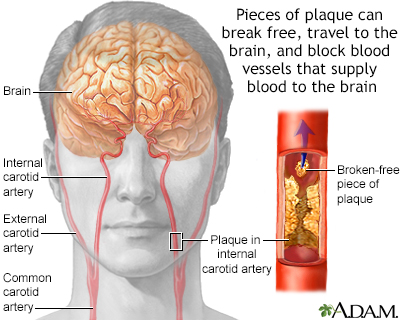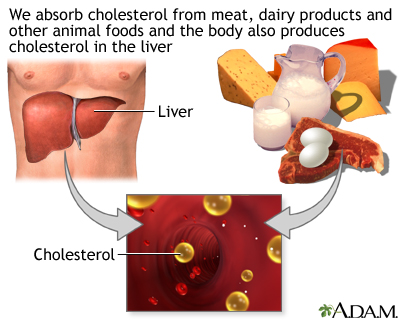Angioplasty and stent placement - carotid artery
The blood vessels that bring blood to your brain and face are called the carotid arteries. You have a carotid artery on each side of your neck.
The blood flow in this artery can become partly or totally blocked by fatty material called plaque. A partial blockage is called carotid artery stenosis (narrowing). A blockage in your carotid artery can reduce the blood supply to your brain. Sometimes part of a plaque can break off, travel downstream and block a brain artery. A stroke can occur if your brain does not get enough blood.
Two procedures can be used to treat a carotid artery that is narrowed or blocked. These are:
- Surgery to remove plaque buildup (endarterectomy)
Endarterectomy
Carotid artery surgery is a procedure to treat carotid artery disease. The carotid artery brings needed blood to your brain and face. You have one o...
 ImageRead Article Now Book Mark Article
ImageRead Article Now Book Mark Article - Carotid artery angioplasty with stent placement

Atherosclerosis of internal carotid artery
The build-up of plaque in the internal carotid artery may lead to narrowing and irregularity of the artery's lumen, preventing proper blood flow to the brain. More commonly, as the narrowing worsens, pieces of plaque in the internal carotid artery can break free, travel to the brain and block blood vessels that supply blood to the brain. This leads to stroke, with possible paralysis or other deficits.
Description
Carotid artery angioplasty and stenting (CAS) is done using a small surgical cut.
- Your surgeon will make a surgical cut in your groin after using some numbing medicine. You will also be given medicine to relax you.
- The surgeon places a catheter (a flexible tube) through the cut into an artery. It is carefully moved up to your neck to the blockage in your carotid artery. Moving x-ray pictures (fluoroscopy) are used to see the artery and guide the catheter to the correct position.
- Next, the surgeon will move a wire through the catheter to the blockage. Another catheter with a very small balloon on the end will be pushed over this wire and into the blockage. Then the balloon is inflated.
- The balloon presses against the inside wall of your artery. This opens the artery and allows more blood to flow to your brain. A stent (a wire mesh tube) may also be placed in the blocked area. The stent is inserted at the same time as the balloon catheter. It expands with the balloon. The stent is left in place to help keep the artery open.
- The surgeon then removes the balloon and catheters.
Stent - Animation
If you have a blocked artery in your heart, legs, or neck, you may need a stent to keep your blood flowing to prevent serious problems. Let's talk today about stents. A stent is a tiny tube we place in an artery, blood vessel, or other duct (such as the one that carries urine) to hold the tubes open. A stent is left in permanently. Most stents are made of metal or plastic mesh-like material. Stent grafts made of fabric are often used in larger arteries. Stents are used to treat a variety of artery and other problems. Your doctor will make a small cut in a blood vessel in your groin and thread a thin, flexible tube called a catheter to the place in your body where you need a stent. In the heart, a fatty substance called plaque can build up inside the coronary arteries. Plaque narrows the arteries, reducing the flow of oxygen-rich blood to the heart. One stent, called an intraluminal coronary artery stent, is a small, self-expanding, metal mesh-like tube that is placed inside a coronary artery after balloon angiography. This stent prevents the artery from re-closing. Another stent is coated with medicine that helps further prevent an artery from re-closing. In the carotid arteries, which are on both sides of your neck, plaque can build up and slow the flow of blood to your brain. Stents can keep the carotid arteries open. Stents can also open up narrow arteries in your legs caused by peripheral arterial disease. They're also used to treat an abdominal aortic aneurysm, which is when the large blood vessel that supplies blood to your abdomen, pelvis, and legs becomes abnormally large and balloons. After a stent procedure, your doctor will probably recommend that you take aspirin and another anti-clotting medication to prevent blood clots from forming in the stent. Make sure that you talk to your doctor, before getting a stent, about the risks associated with placing a stent to treat your condition, such as tissue growing around the area where the stent was placed.
Why the Procedure Is Performed
Carotid artery surgery (endarterectomy) is a well-established and effective way to treat narrowed or blocked arteries. This procedure is very safe.
CAS has developed as a good alternative to surgery in some cases, when done by experienced surgeons. Certain factors may favor stenting, such as:
- The person is too ill to have carotid endarterectomy.
- The location of the narrowing in the carotid artery makes surgery harder.
- The person has had neck or carotid surgery in the past.
- The person has had radiation to the neck.
Risks
Risks of CAS, which depend on factors such as age, are:
- Allergic reaction to dye
- Blood clots or bleeding at the site of surgery
Blood clots
Blood clots are clumps that occur when blood hardens from a liquid to a solid. A blood clot that forms inside one of your veins or arteries is calle...
 ImageRead Article Now Book Mark Article
ImageRead Article Now Book Mark Article - Brain damage
- Clogging of the inside of the stent (in-stent restenosis)
- Heart attack
Heart attack
Most heart attacks are caused by a blood clot that blocks one of the coronary arteries. The coronary arteries bring blood and oxygen to the heart. ...
 ImageRead Article Now Book Mark Article
ImageRead Article Now Book Mark Article - Kidney failure (higher risk in people who already have kidney problems)
- More blockage of the carotid artery over time
- Seizures (this is rare)
Seizures
A seizure is the physical changes in behavior that occurs during an episode of specific types of abnormal electrical activity in the brain. The term ...
 ImageRead Article Now Book Mark Article
ImageRead Article Now Book Mark Article - Stroke
Stroke
A stroke occurs when blood flow to a part of the brain stops. A stroke is sometimes called a "brain attack. " If blood flow is cut off for longer th...
 ImageRead Article Now Book Mark Article
ImageRead Article Now Book Mark Article
Before the Procedure
Your health care provider will do a physical exam and perform several medical tests.
Always tell your provider what medicines you are taking, including drugs, supplements, or herbs you bought without a prescription.
During the 2 weeks before your procedure:
- Days before the surgery, you may have to stop taking blood thinner such as aspirin, ibuprofen (Advil, Motrin), clopidogrel (Plavix), ticagrelor (Brilinta), prasugrel (Effient), naproxen (Aleve, Naprosyn), and other medicines like these.
- Ask your provider which medicines you should still take on the day of your surgery.
- If you smoke, you need to stop. Ask your provider for help quitting.
- Always let your provider know about any cold, flu, fever, herpes breakout, or other illness you may have before your surgery.
DO NOT drink anything after midnight the night before your surgery, including water.
On the day of your surgery:
- Take the medicines you have been told to take with a small sip of water.
- You will be told when to arrive at the hospital.
After the Procedure
After surgery, you may need to stay in the hospital overnight so that you can be watched for any signs of bleeding, stroke, or poor blood flow to your brain. You may be able to go home the same day if your procedure is done early in the day and you are doing well. Your provider will talk to you about how to care for yourself at home.
How to care for yourself
You had an angioplasty of your carotid artery done when you were in the hospital. You may have also had a stent (a tiny wire mesh tube) placed in th...

Outlook (Prognosis)
Carotid artery angioplasty and stenting may help lower your chance of having a stroke. But you may need to make lifestyle changes, such as change in diet and regular exercise, to help prevent plaque buildup, blood clots, and other problems in your carotid arteries over time. In addition, your provider will recommend medicines to further reduce your chance of a stroke.

Cholesterol producers
Cholesterol is a waxy, fat-like material that is found in all parts of the body. It comes from two sources: our liver produces it, and we consume it in animal products.
Reviewed By
Luc Jasmin, MD, Ph.D., FRCS (C), FACS, Department of Surgery, Johnson City Medical Center, TN; Department of Maxillofacial Surgery at UCSF, San Francisco, CA. Review provided by VeriMed Healthcare Network. Internal review and update on 02/23/24 by David C. Dugdale, MD, Medical Director, Brenda Conaway, Editorial Director, and the A.D.A.M. Editorial team.
Deery SE, Hicks CW. Carotid artery stenting. In: Sidawy AN, Perler BA, eds. Rutherford's Vascular Surgery and Endovascular Therapy. 10th ed. Philadelphia, PA: Elsevier; 2023:chap 94.
Hassani S, Fisher M. Management of atherosclerotic carotid artery disease: a brief overview and update. Am J Med. 2022;135(4):430-434. PMID: 34732352 pubmed.ncbi.nlm.nih.gov/34732352/.
Kinlay S, Bhatt DL. Treatment of noncoronary obstructive vascular disease. In: Libby P, Bonow RO, Mann DL, Tomaselli GF, Bhatt DL, Solomon SD, eds. Braunwald's Heart Disease: A Textbook of Cardiovascular Medicine. 12th ed. Philadelphia, PA: Elsevier; 2022:chap 44.
Kleindorfer DO, Towfighi A, Chaturvedi S, et al. 2021 guideline for the prevention of stroke in patients with stroke and transient ischemic attack: A guideline from the American Heart Association/American Stroke Association. Stroke. 2021;52(7):e364-e467. PMID: 34024117 pubmed.ncbi.nlm.nih.gov/34024117/.
Rosenfield K, Matsumura JS, Chaturvedi S, et al. Randomized trial of stent versus surgery for asymptomatic carotid stenosis. N Engl J Med. 2016;374(11):1011-1020. PMID: 26886419 pubmed.ncbi.nlm.nih.gov/26886419/.


 All rights reserved.
All rights reserved.